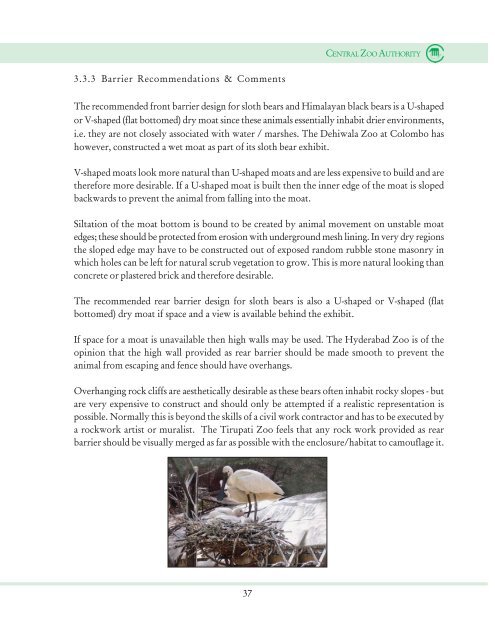Barrier Designs for Zoos - ZooLex Zoo Design Organization
Barrier Designs for Zoos - ZooLex Zoo Design Organization
Barrier Designs for Zoos - ZooLex Zoo Design Organization
Create successful ePaper yourself
Turn your PDF publications into a flip-book with our unique Google optimized e-Paper software.
3.3.3 <strong>Barrier</strong> Recommendations & Comments<br />
37<br />
CENTRAL ZOO AUTHORITY<br />
The recommended front barrier design <strong>for</strong> sloth bears and Himalayan black bears is a U-shaped<br />
or V-shaped (flat bottomed) dry moat since these animals essentially inhabit drier environments,<br />
i.e. they are not closely associated with water / marshes. The Dehiwala <strong>Zoo</strong> at Colombo has<br />
however, constructed a wet moat as part of its sloth bear exhibit.<br />
V-shaped moats look more natural than U-shaped moats and are less expensive to build and are<br />
there<strong>for</strong>e more desirable. If a U-shaped moat is built then the inner edge of the moat is sloped<br />
backwards to prevent the animal from falling into the moat.<br />
Siltation of the moat bottom is bound to be created by animal movement on unstable moat<br />
edges; these should be protected from erosion with underground mesh lining. In very dry regions<br />
the sloped edge may have to be constructed out of exposed random rubble stone masonry in<br />
which holes can be left <strong>for</strong> natural scrub vegetation to grow. This is more natural looking than<br />
concrete or plastered brick and there<strong>for</strong>e desirable.<br />
The recommended rear barrier design <strong>for</strong> sloth bears is also a U-shaped or V-shaped (flat<br />
bottomed) dry moat if space and a view is available behind the exhibit.<br />
If space <strong>for</strong> a moat is unavailable then high walls may be used. The Hyderabad <strong>Zoo</strong> is of the<br />
opinion that the high wall provided as rear barrier should be made smooth to prevent the<br />
animal from escaping and fence should have overhangs.<br />
Overhanging rock cliffs are aesthetically desirable as these bears often inhabit rocky slopes - but<br />
are very expensive to construct and should only be attempted if a realistic representation is<br />
possible. Normally this is beyond the skills of a civil work contractor and has to be executed by<br />
a rockwork artist or muralist. The Tirupati <strong>Zoo</strong> feels that any rock work provided as rear<br />
barrier should be visually merged as far as possible with the enclosure/habitat to camouflage it.
















